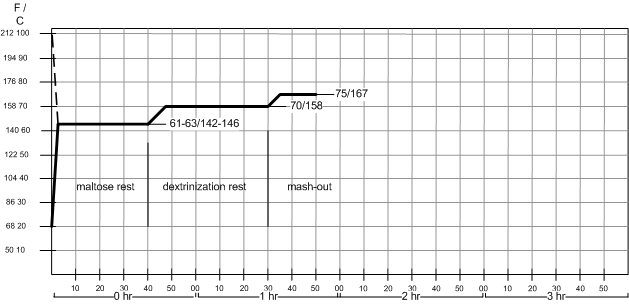Where's Jim?
Active Member
- Joined
- 19/9/11
- Messages
- 39
- Reaction score
- 0
I still consider myself new to this business but I have a curious thought and didn't even know where to begin searching so here we go.
...Say we have the following mash schedule (taken to a few extremes):
45minutes at 61degC
raise to;
45minutes at 69degC
So basically the first temperature gets the beta-amylase going and the second step gets the alpha-amylase going.
Say we have a recipe that contains;
80% Base Malt
10% Spec Malt A
10% Spec Malt B
We mash the base malt and spec malt A at 61 for 45minutes and then raise the mash to 69, add spec malt B and hold for 45minutes.
Would Spec Malt B produce more complex chains than Spec Malt A and thus provide more of it's own speciality sweetness than those produced by Spec Malt A?
OR
Would the extra time spent at the higher sacc temp make the lower sacc temp redundant?
IN A NUTSHELL;
If you add a speciality malt at the second sacc temperature will it provide a more specific sweetness to the finished beer as opposed to adding it at the start along with all of your other grains?
OR
Does this f***ing around just somehow make itself a redundant process?
OR
Feel free to shoot down the stupidity of me even contemplating this idea.

Cheers.
...Say we have the following mash schedule (taken to a few extremes):
45minutes at 61degC
raise to;
45minutes at 69degC
So basically the first temperature gets the beta-amylase going and the second step gets the alpha-amylase going.
Say we have a recipe that contains;
80% Base Malt
10% Spec Malt A
10% Spec Malt B
We mash the base malt and spec malt A at 61 for 45minutes and then raise the mash to 69, add spec malt B and hold for 45minutes.
Would Spec Malt B produce more complex chains than Spec Malt A and thus provide more of it's own speciality sweetness than those produced by Spec Malt A?
OR
Would the extra time spent at the higher sacc temp make the lower sacc temp redundant?
IN A NUTSHELL;
If you add a speciality malt at the second sacc temperature will it provide a more specific sweetness to the finished beer as opposed to adding it at the start along with all of your other grains?
OR
Does this f***ing around just somehow make itself a redundant process?
OR
Feel free to shoot down the stupidity of me even contemplating this idea.
Cheers.





